What is the UK's favourite insect?
The buff-tailed bumblebee has been crowned the Favourite UK Insect after winning a public poll of 7,500 votes.
It would appear Bombus terrestris, is most certainly ‘queen bee’, securing victory with over 40% of the vote.
Insects are vital for human life on earth but are often overlooked. There are over 20,000 insect species found in the UK, and expert ecologists came up with a list of 10 of their favourite species and we wanted to know what the rest of the UK thought...
The poll opened in August and closed 25th September 2015. Thanks to everyone who voted. Continue to share your favourite using #UKInsectPoll
 1st - The Bees Knees - Buff-tailed Bumblebee
1st - The Bees Knees - Buff-tailed Bumblebee
Bumblebees have large furry bottoms, but their name refers to their hum, not their bum. The buff-tailed bumblebee is named after the queen’s buff-coloured ‘tail’. It is the earliest bumblebee you are likely to see in your garden, with the fat queen buff-tailed bumblebee emerging first, to replenish her food reserves. Have you spotted the buff-tailed bumblebee in your garden?
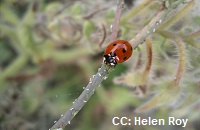 2nd - The Divine Messenger - Seven-spot Ladybird
2nd - The Divine Messenger - Seven-spot Ladybird
The seven-spot ladybird is very widespread, found throughout the UK. It is a ubiquitous inhabitant of gardens and parks and will turn up anywhere there are aphids to feed on. In the middle ages it was considered a messenger from the heavens as it incorporated the mystic number seven (seven joys and seven sorrows). Heavenly or not, the bright colours of a ladybird serve as a warning to predators to stay away. The beetle has a strong distaste, although some birds may still have a go at eating them. An angelic insect or just a familiar garden friend, but is it your favourite?
 3rd - Lord of the Skies - Emperor Dragonfly
3rd - Lord of the Skies - Emperor Dragonfly
The emperor dragonfly is a very large, impressive dragonfly, the biggest in the UK. Perhaps the most dazzling of insects: a colourful acrobat with large wings on a broomstick body. The dragonfly will fiercely defend its territory, tirelessly patrolling the margins of ponds and lakes. The emperor dragonfly is perhaps one of the most impressive, but do you agree?
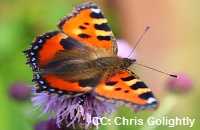 4th - The House Sitter - Small Tortoiseshell
4th - The House Sitter - Small Tortoiseshell
One of our most familiar butterflies, visiting gardens to feast on buddleia and ice-plants. The small tortoiseshell is perfectly named, given its orange, white and black colouration and is one of the emblems of sunny days in the garden, and its colourful form encapsulates all our pleasant associations with butterflies. It used to be very common, but its numbers have fallen dramatically since 2005. It is believed this is largely due to the parasitic fly, sturmia bella. It is also the butterfly most likely to hibernate inside the house. Would it be welcome in your home?
 5th - The Big Daddy - Stag Beetle
5th - The Big Daddy - Stag Beetle
The stag beetle is the UK's largest beetle, and one of the most distinct, particularly the males, with their antler-like jaws used to fight over females. The stag beetle spends most of its time as a larva, and its adult stage is short lived, serving only as a time to find a mate and lay eggs. The plump white larvae depend on old trees and rotting wood to live in and feed on, and can take up to six years to develop before they pupate and turn into adults. Regarded with both admiration and fear, it is the only UK insect to have featured on a postage stamp twice!
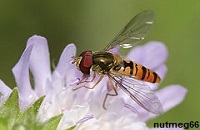 6th - The Gardener's Friend - Marmalade Hoverfly
6th - The Gardener's Friend - Marmalade Hoverfly
Hoverflies are among the friendliest and least disconcerting of flies, hovering effortlessly at flowers. Hoverflies are the most popular groups of flies. Many gardeners go out of their way to attract them, and to some they are considered the ‘butterflies of the flies’. They are very important pollinators, as well as pest controllers. The larvae of marmalade hoverflies, like ladybirds, are predators of aphids.
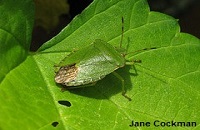 7th - Kicking up a stink - Green Shieldbug
7th - Kicking up a stink - Green Shieldbug
Shield bugs are 'true bugs' belonging to the order Hemiptera. Being less skittish than many insects, Shieldbugs often allow us to get a good look at their squat, geometrically shaped bodies, whether it be basking on a leaf, or running along the ground. The green shieldbug is a recent beneficiary of climate change. It was once restricted to southern England, but it is now common and widespread across much of England and Wales, and spreading ever northwards. Have you seen one where you live?
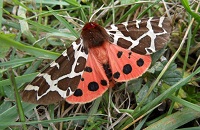 8th - The Woolly Bear - Garden Tiger Moth
8th - The Woolly Bear - Garden Tiger Moth
The garden tiger moth is a striking beauty and one of the best known moths in the UK. Tiger moth’s names are a slight misnomer; most tiger moths are spotted not striped. They should strictly be called leopard moths. The hairy, fast moving caterpillar is also well known and recognisable, most commonly referred to as ‘woolly bears’. In 19th century Shropshire, it was considered good luck to have a 'woolly bear' crawl up your leg. Would you welcome a woolly bear on the leg?
 9th - The Socialite - Black Garden Ant
9th - The Socialite - Black Garden Ant
Ants are not big on individuality; instead, most live for the colony, a tightly knit organisation, formed by altruistic cooperation, with interior networks, caste systems and even a kind of chemical language. During hot and humid summer weather, winged adults appear and swarm in large numbers; these 'flying ants' mate and eventually disperse to form new colonies. They commonly seem to appear on the same #FlyingAntDay in different locations in the UK. Are you an admirer of the colony?
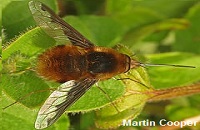 10th - The Impersonator - Large Bee-fly
10th - The Impersonator - Large Bee-fly
There are more than a dozen species of bee-fly in the UK, but the large bee-fly is one of the most common. It is a bee mimic; a tiny, furry ball of an insect, with a long stiff tongue out in front like a drawn out sword, with long hairy legs. Don’t be too fooled by its friendly image however, as after laying its eggs near the entrance of underground nests of solitary bees and wasps, the carnivorous bee-fly larvae feed on the larvae of bees - the very animal it mimics.
Find out more and get involved
Many of our insect species are threatened as a result of loss of habitat, climate change, pollution, the presence of invasive species and the use of pesticides. Now more than ever, they need our attention, protection and conservation. Everyone can do their bit to help.
- Visit the Amateur Entomologists' Society website for more insect facts, activities and information
- Find out more about invertebrate conservation in the UK on the Zoological Society of London website
- Read about insects and other UK species on the British Ecological Society website
- Discover more about pollinators and take part in the Polli:Nation project with the Field Studies Council
Give nature a home
- Get lots of handy tips on how you can encourage insects and other wildlife to your garden on the RSPB Give Nature a Home website
Help record insects
- If you have a photo of something and you don’t know what it is, you can upload it to the iSpot website and get help from experts online
- Help experts by logging your sightings online via iRecord or by downloading some helpful recording apps
- Take part in citizen science surveys including: flying ant survey, bee watch, ladybird survey, big butterfly count, great stag hunt, national moth recording scheme, Dragonfly Recording Network
- Finally, you can download easy to use wildlife survey kits from OPAL, and help record wildlife in different habitats

